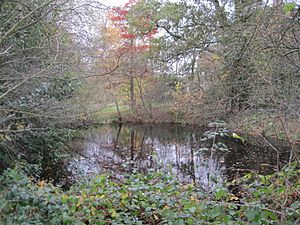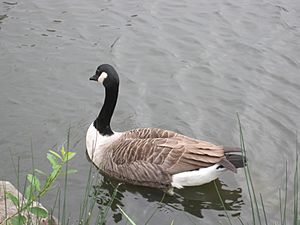Totteridge Common facts for kids
Totteridge Common is a special natural area in Totteridge, a part of London. It covers about 3.7 hectares (which is like 9 football fields!). This place is so important for nature that it's officially recognized as a "Site of Borough Importance for Nature Conservation, Grade II." This means it's a really valuable spot for plants and animals in the local area.
The common is located along the southern side of the road called Totteridge Common, between Totteridge Park and Oak Lodge. It's a piece of land that everyone can use, and it's looked after by a group called the Totteridge Manor Association. This land used to be part of a large estate called the Manor of Totteridge before it was given to the association in 1954.
A Home for Wildlife
One of the most exciting parts of Totteridge Common for nature lovers is its series of old ponds. Starting from the east, you'll find Burnham's Pond, Warren Pond, Long Pond, Ellern Mede Pond, and Pink Cottage Pond. Each pond is a little different, but they all have amazing wetland plants. They are also super important homes for creatures like dragonflies, other small insects, and amphibians such as frogs and newts.
Pond Life: Plants and Animals
Around the edges of these ponds, you can spot cool plants like lesser spearwort, which has bright yellow flowers, and trifid bur-marigold. You might also see fool's watercress, which looks a bit like the watercress you eat! In the deeper parts of the water, beautiful white water-lilies float on the surface. You can also find different types of pondweed, like curled pondweed and broad-leaved pondweed. If you like fishing, you'll be happy to know that Long Pond is a popular spot for angling.
Trees and Grasslands
Beyond the ponds, Totteridge Common also has open grassy areas, scattered trees, and some overgrown hedgerows. There are also several small patches of woodland. The trees in these woods are mostly sycamore and elm trees.
You can also find two young native black poplar trees here. These trees are quite rare in Britain and are considered a "priority species" in London's plan to protect its biodiversity. This means they are very important to look after! There are also some big, old oak trees and horse-chestnut trees spread across the common.
The grassy areas are home to many different kinds of wildflowers. In the damp spots near some of the ponds, you'll see a lot of tufted hair-grass, which grows in clumps.




